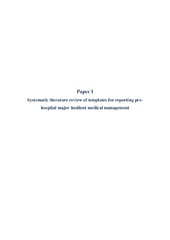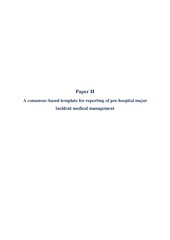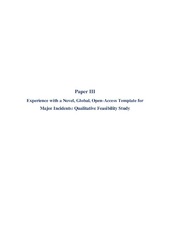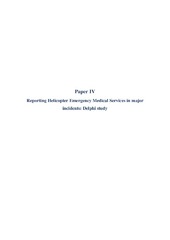| dc.contributor.advisor | Wisborg, Torben | |
| dc.contributor.author | Fattah, Sabina | |
| dc.date.accessioned | 2017-07-27T08:41:59Z | |
| dc.date.available | 2017-07-27T08:41:59Z | |
| dc.date.issued | 2017-06-16 | |
| dc.description.abstract | Storulykker er krevende for prehospitale medisinske tjenester over hele verden. Vi vet at de samme problemene viser seg gang på gang. Hvordan kan de prehospitale tjenestene lære av tidligere erfaringer?
På grunn av storulykkers (engelsk: major incidents) omfattende betydning for menneskeliv og samfunn er det nødvendig å standardisere rapporteringen fra hendelsene. Dette kan muliggjøre analyser som sammenlikner hendelsene og identifiserer læringsmomenter. Tilsvarende innsats for å standardisere helseregistre på andre områder har tilrettelagt for sammenligningsstudier, samt gjort det mulig å identifisere forbedringspunkter. Vi antar at det samme vil gjelde for storulykker. Målet med denne avhandlingen var å tilrettelegge for systematisk innsamling av standardiserte data fra den prehospitale medisinske håndteringen av storulykker. Dette vil kunne øke kvaliteten på forskning og erfaringsformidling vedrørende prehospital innsats ved storulykker og potensielt forbedre kvaliteten på redningsarbeidet. Ved å standardisere data og tilrettelegge for analyser kan man redusere skadevirkningene av fremtidige hendelser, og den prehospitale medisinske responsen kan forbedres. Fire studier inngår i avhandlingen.
Vi gjennomført en systematisk litteraturgjennomgang for å identifisere innhold i eksisterende rapporteringsmaler for storulykker. Fordi det ikke fantes en egnet rapporteringsmal gjennomførte vi en konsensusprosess for å konstruere en slik mal. Etter implementering av denne, gjennomførte vi en pilotstudie for å undersøke hvor anvendelig malen var til å registrere de ønskede data. Malen ble så revidert på bakgrunn av funnene. En egen mal for rapportering av luftambulanserespons i storulykker ble senere utviklet ved hjelp av konsensusmetodologi. Begge rapporteringsmal er fritt tilgjengelig på www.majorincidentreporting.net.
Avhandlingen viser hvordan systematisk litteraturgjennomgang kan være nyttig for å identifisere eksisterende kunnskap og vurdere behovet for et nytt forskningsprosjekt. Avhandlingen fant at det var nødvendig å lage en konsensusbasert mal for å rapportere den prehospitale medisinske responsen ved en storulykke. Det var mulig å oppnå konsensus, lage en rapporteringsdatabase og å få fagfolk til å bruke rapporteringsmalen.
Hovedutfordringene har vært at et lavt antall fagpersoner foreløpig har rapportert fra hendelser, og derfor deltok få respondenter i studien som så på anvendbarheten. Det lave antallet rapporter er også en utfordring når det skal gjøres analyser som sammenlikner data fra hendelsene. Gitt den relativt korte tiden som rapporteringsmalene har vært tilgjengelig, er det likevel grunn til optimisme med hensyn til mulighetene for å få gjennomført slike studier i fremtiden. | en_US |
| dc.description.abstract | Major incidents put Emergency Medical Services (EMS) to the test daily across the globe. Despite the same problems re-occurring, we fail to learn from them. How can EMS learn from these incidents?
Given the impact of major incidents on human lives and society, reporting should be standardised so that comparative analyses can be performed and learned lessons identified. Previous efforts aiming to standardise reporting, such as the creation of health registries, have been useful for generating research data and investigating associations. One might assume that the same applies for data from major incident medical responses. The aim of this thesis was to contribute to the systematic collection of standardised data from the pre-hospital medical management of major incidents and to enable identification of what could have been improved and what worked well in the response phase to a major incident. Four studies conducted along this aim are presented in this thesis.
We performed a systematic review to identify the content of existing major incident reporting templates. Due to the lack of a suitable template a consensus process was utilised to create a general template for reporting pre-hospital medical management of major incidents. Following implementation, a pilot feasibility study was conducted to identify users’ experiences. The template was revised accordingly. Later a template for reporting HEMS response to major incidents was developed using consensus methodology. Both templates are freely available on www.majorincidentreporting.net.
This thesis shows how systematic literature review can be useful in identifying current knowledge and assessing the need for a new research project. We demonstrate a need for new consensus-based, open access templates for reporting the pre-hospital medical response to major incidents. We show that it was possible to achieve consensus, create a database, and have people submit reports using the template.
The main challenges have been recruiting reports, resulting in a low number of respondents in the study aiming to identify feasibility. Low rates of submitted reports also present a challenge in conducting comparative analyses of incidents. However, given the relatively short timeframe in which the template has been available, there is reason to remain optimistic about the chances of conducting such studies in the future. | en_US |
| dc.description.doctoraltype | ph.d. | en_US |
| dc.description.popularabstract | Major incidents put Emergency Medical Services to the test daily across the globe. Given the impact of major incidents on human lives and society, reporting should be standardised so that comparative analyses of incidents can be performed and learned lessons identified. The aim of this thesis was to contribute to such reporting.
A systematic review was performed to identify existing major incident reporting templates. Due to the lack of a suitable template expert opinion was utilised to create a novel template for reporting pre-hospital major incident medical management. A study was conducted to identify users’ experiences with the template and it was revised according to feedback. Later a template for reporting Helicopter Emergency Medical Services response to major incidents was developed using expert opinion. Both templates are freely available on www.majorincidentreporting.net.
The main challenge has been recruiting reports. Given the relatively short timeframe in which the template has been available, there is reason to remain optimistic about the chances of further implementation of the reporting site and thus conducting more studies in the future. | en_US |
| dc.description.sponsorship | Norwegian Air Ambulance Foundation | en_US |
| dc.identifier.uri | https://hdl.handle.net/10037/11256 | |
| dc.language.iso | eng | en_US |
| dc.publisher | UiT The Arctic University of Norway | en_US |
| dc.publisher | UiT Norges arktiske universitet | en_US |
| dc.rights.accessRights | openAccess | en_US |
| dc.rights.holder | Copyright 2017 The Author(s) | |
| dc.rights.uri | https://creativecommons.org/licenses/by-nc-sa/3.0 | en_US |
| dc.rights | Attribution-NonCommercial-ShareAlike 3.0 Unported (CC BY-NC-SA 3.0) | en_US |
| dc.subject | VDP::Medical disciplines: 700::Health sciences: 800::Health service and health administration research: 806 | en_US |
| dc.subject | VDP::Medisinske Fag: 700::Helsefag: 800::Helsetjeneste- og helseadministrasjonsforskning: 806 | en_US |
| dc.title | Systematic reporting of pre-hospital major incident medical management - identifying needs, a suggested solution and assessing implementation | en_US |
| dc.type | Doctoral thesis | en_US |
| dc.type | Doktorgradsavhandling | en_US |


 English
English norsk
norsk




